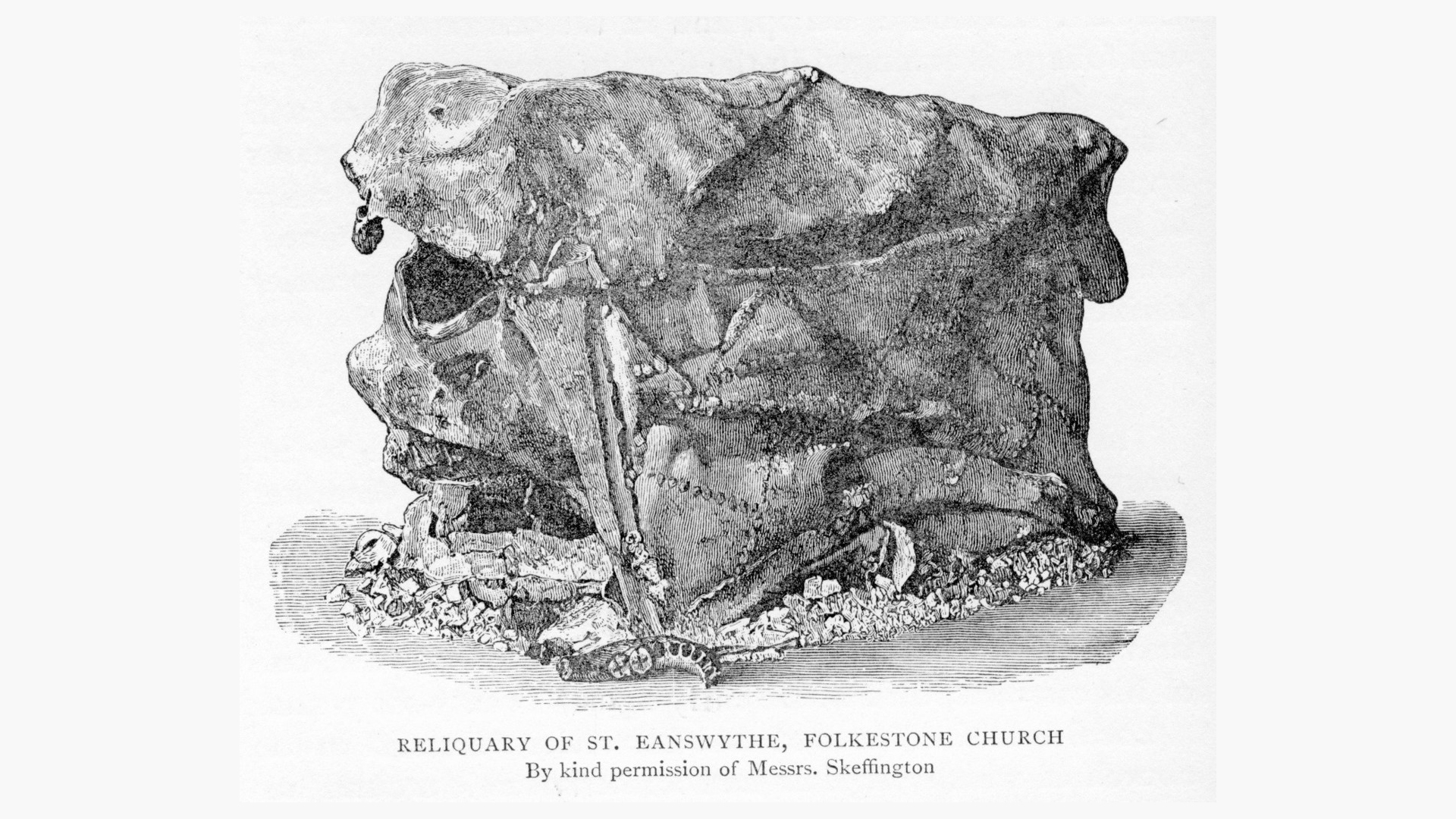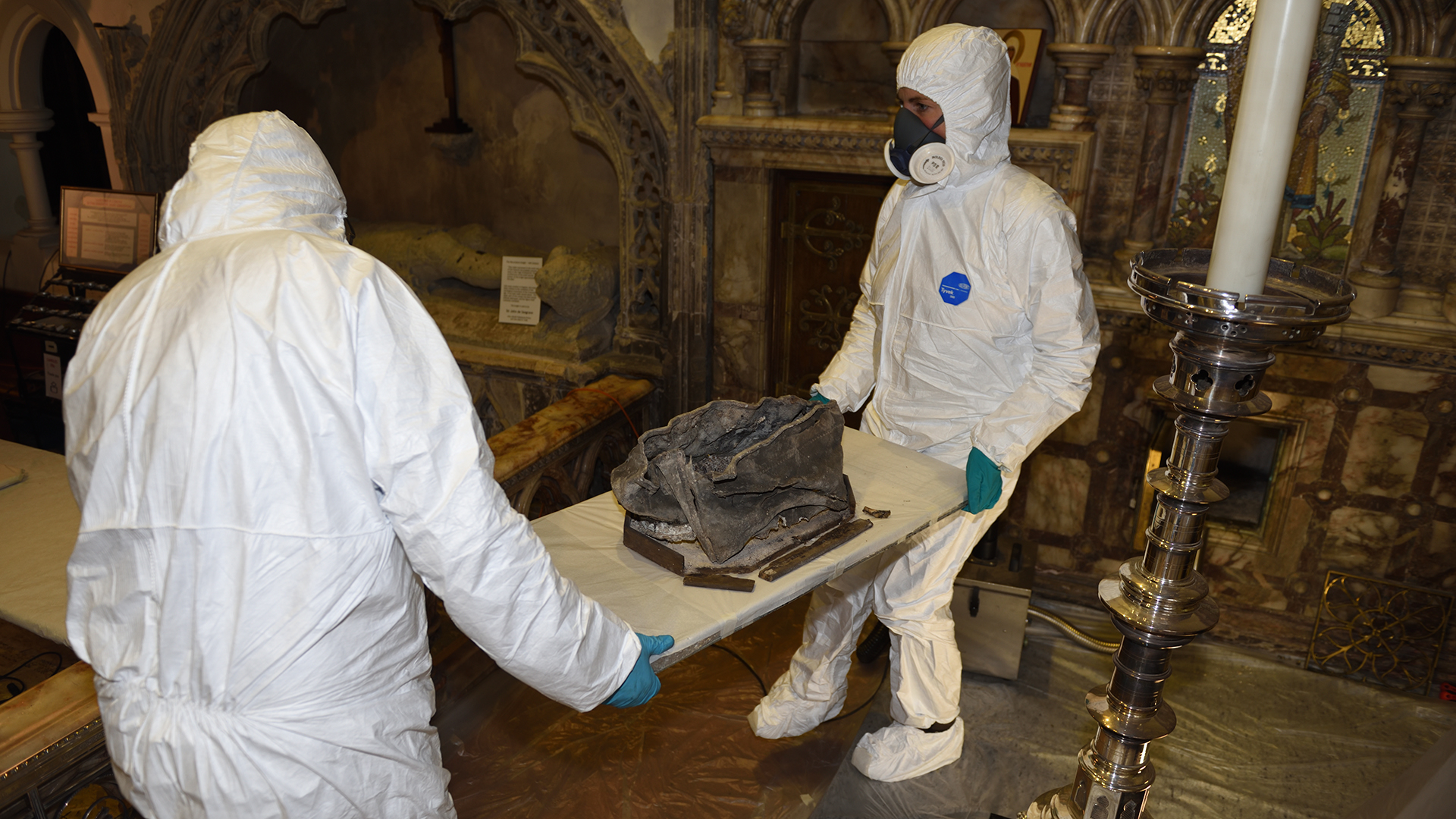Bones found in a church are earliest verified remains of an English saint
Saint Eanswythe is thought to have died young, in her late teens or early 20s.

Archaeologists have identified the bones of one England's earliest saints. The remains were found hidden behind a church wall in the southern part of the country.
Her name was Eanswythe (pronounced AYNS-wyth), and she wasn't just a saint; she was also a princess, the granddaughter of Ethelbert, the first Christian king of Kent and ruler of the east of England from A.D. 580 until his death in A.D. 616, according to the Canterbury Historical and Archaeological Society.
The bones were found more than a century ago, in the Church of St. Mary and St. Eanswythe in Folkestone, a port town in southeastern England, representatives of the Diocese of Canterbury said in a statement released on March 6. Though people immediately suspected that the bones came from the young saint, the remains were never thoroughly analyzed until now.
After extensive testing, archaeologists and historians have announced that the bones were indeed St. Eanswythe's, and are England's earliest verified remains of a saint. The bones were likely hidden away to protect them from destruction during the Protestant Reformation, according to the statement.
Related: Religious mysteries: 8 alleged relics of Jesus
Eanswythe was born in the A.D. 630s or very early A.D. 640s, during the dawn of Christianity in England. At her request, her father, King Eadbald, built her a monastery in Folkestone, and she joined the institution when she was 16 years old. It was England's first monastery for women, and Eanswythe became the abbess before she died, between A.D. 653 and 663, said Andrew Richardson, an archaeologist with the Canterbury Archaeological Trust and a specialist in the archaeology of the Kingdom of Kent.
"I suspect that her early death at such a young age — 17 to 20, 22 at the most — perhaps just after becoming the founding abbess of one of England's first monastic institutions that included women, plus the fact that she was of the Kentish royal house (beloved by the Church as the first to convert to Christianity), would have easily been enough to get her acclaimed as a saint, perhaps within only a few years of her death," Richardson told Live Science in an email.
Sign up for the Live Science daily newsletter now
Get the world’s most fascinating discoveries delivered straight to your inbox.
"She was, though, along with her aunt Ethelburga, the first of the female English saints," Richardson said.
"In a crumbling condition"
Workers discovered the bones in 1885 while removing plaster from a niche in the Folkestone church's northern wall, The New York Times reported on Aug. 9 that year.
"Taking away a layer of rubble and broken tiles, a cavity was discovered, and in this [was found] a broken and corroded leaden casket, oval shaped, about 18 inches [46 centimeters] long and 12 inches [31 cm] broad, the sides being about 10 inches [25 cm] high," according to The Times.
Tucked away inside the casket were human bones, "but in such a crumbling condition that the vicar declined to allow them to be touched except by experts," the Times reported.
Related: In photos: Rare Anglo-Saxon cemetery uncovered

For the recent evaluation of the bones, which, due to their religious significance, could not be removed, researchers set up a lab in the church — even sleeping there overnight when necessary, Richardson said.
The scientists determined that the remains belonged to a young woman and the bones showed no signs of malnutrition. Radiocarbon dating of tooth and bone samples revealed that the woman died in the mid-seventh century, while multiple historic records from the 10th century through the 16th century mentioned Folkestone as the resting place for Eanswythe's remains, Richardson said.
"We know there was a shrine to her until the 1530s, when the church at Folkestone (which was a priory with monks) surrendered to Henry VIII's men," Richardson said in the email. "It was usual at that point that any shrines or relics would be destroyed. But in this case, her bones were concealed in a lead container in the wall beneath her shrine. When this was discovered by workmen in June 1885, it was immediately thought the remains might be hers," Richardson said.

Combined with historic records, the new analysis provides strong evidence that the bones belong to St. Eanswythe.
"It is actually quite hard to see a more plausible reason why a young woman who died in the mid-7th century was found concealed in the wall of a 12th-century church, below what was probably the location of St. Eanswythe's medieval shrine," Richardson said.
Further tests are planned for the bones, including genetic analysis and an analysis of the different versions of atomic elements in the bones, according to the Diocese of Canterbury statement. That could provide more details about this historic figure and will help officials determine how the remains should be preserved and displayed, representatives said.
Editor's note: This article was updated on March 12 to correct the estimated date of Eanswythe's birth.
- The 10 most controversial miracles
- In photos: Scotland's cave of the dead
- Photos: Mysterious braided hair found in medieval abbey
Originally published on Live Science.
OFFER: Save at least 53% with our latest magazine deal!
With impressive cutaway illustrations that show how things function, and mindblowing photography of the world’s most inspiring spectacles, How It Works represents the pinnacle of engaging, factual fun for a mainstream audience keen to keep up with the latest tech and the most impressive phenomena on the planet and beyond. Written and presented in a style that makes even the most complex subjects interesting and easy to understand, How It Works is enjoyed by readers of all ages.

Mindy Weisberger is an editor at Scholastic and a former Live Science channel editor and senior writer. She has reported on general science, covering climate change, paleontology, biology and space. Mindy studied film at Columbia University; prior to Live Science she produced, wrote and directed media for the American Museum of Natural History in New York City. Her videos about dinosaurs, astrophysics, biodiversity and evolution appear in museums and science centers worldwide, earning awards such as the CINE Golden Eagle and the Communicator Award of Excellence. Her writing has also appeared in Scientific American, The Washington Post and How It Works Magazine. Her book "Rise of the Zombie Bugs: The Surprising Science of Parasitic Mind Control" will be published in spring 2025 by Johns Hopkins University Press.











